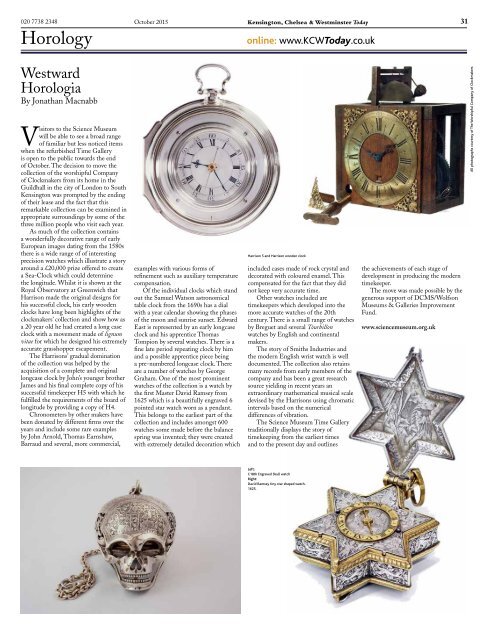CITIZENS
TnqFN
TnqFN
Create successful ePaper yourself
Turn your PDF publications into a flip-book with our unique Google optimized e-Paper software.
020 7738 2348<br />
Horology<br />
October 2015<br />
Kensington, Chelsea & Westminster Today 31<br />
online: www.KCWToday.co.uk<br />
Westward<br />
Horologia<br />
By Jonathan Macnabb<br />
Visitors to the Science Museum<br />
will be able to see a broad range<br />
of familiar but less noticed items<br />
when the refurbished Time Gallery<br />
is open to the public towards the end<br />
of October. The decision to move the<br />
collection of the worshipful Company<br />
of Clockmakers from its home in the<br />
Guildhall in the city of London to South<br />
Kensington was prompted by the ending<br />
of their lease and the fact that this<br />
remarkable collection can be examined in<br />
appropriate surroundings by some of the<br />
three million people who visit each year.<br />
As much of the collection contains<br />
a wonderfully decorative range of early<br />
European images dating from the 1580s<br />
there is a wide range of of interesting<br />
precision watches which illustrate a story<br />
around a £20,000 prize offered to create<br />
a Sea-Clock which could determine<br />
the longitude. Whilst it is shown at the<br />
Royal Observatory at Greenwich that<br />
Harrison made the original designs for<br />
his successful clock, his early wooden<br />
clocks have long been highlights of the<br />
clockmakers’ collection and show how as<br />
a 20 year old he had created a long case<br />
clock with a movement made of lignum<br />
vitae for which he designed his extremely<br />
accurate grasshopper escapement.<br />
The Harrisons’ gradual domination<br />
of the collection was helped by the<br />
acquisition of a complete and original<br />
longcase clock by John’s younger brother<br />
James and his final complete copy of his<br />
successful timekeeper H5 with which he<br />
fulfilled the requirements of the board of<br />
longitude by providing a copy of H4.<br />
Chronometers by other makers have<br />
been donated by different firms over the<br />
years and include some rare examples<br />
by John Arnold, Thomas Earnshaw,<br />
Barraud and several, more commercial,<br />
examples with various forms of<br />
refinement such as auxiliary temperature<br />
compensation.<br />
Of the individual clocks which stand<br />
out the Samuel Watson astronomical<br />
table clock from the 1690s has a dial<br />
with a year calendar showing the phases<br />
of the moon and sunrise sunset. Edward<br />
East is represented by an early longcase<br />
clock and his apprentice Thomas<br />
Tompion by several watches. There is a<br />
fine late period repeating clock by him<br />
and a possible apprentice piece being<br />
a pre-numbered longcase clock. There<br />
are a number of watches by George<br />
Graham. One of the most prominent<br />
watches of the collection is a watch by<br />
the first Master David Ramsey from<br />
1625 which is a beautifully engraved 6<br />
pointed star watch worn as a pendant.<br />
This belongs to the earliest part of the<br />
collection and includes amongst 600<br />
watches some made before the balance<br />
spring was invented; they were created<br />
with extremely detailed decoration which<br />
Harrison 5 and Harrison wooden clock<br />
included cases made of rock crystal and<br />
decorated with coloured enamel. This<br />
compensated for the fact that they did<br />
not keep very accurate time.<br />
Other watches included are<br />
timekeepers which developed into the<br />
more accurate watches of the 20th<br />
century. There is a small range of watches<br />
by Breguet and several Tourbillon<br />
watches by English and continental<br />
makers.<br />
The story of Smiths Industries and<br />
the modern English wrist watch is well<br />
documented. The collection also retains<br />
many records from early members of the<br />
company and has been a great research<br />
source yielding in recent years an<br />
extraordinary mathematical musical scale<br />
devised by the Harrisons using chromatic<br />
intervals based on the numerical<br />
differences of vibration.<br />
The Science Museum Time Gallery<br />
traditionally displays the story of<br />
timekeeping from the earliest times<br />
and to the present day and outlines<br />
the achievements of each stage of<br />
development in producing the modern<br />
timekeeper.<br />
The move was made possible by the<br />
generous support of DCMS/Wolfson<br />
Museums & Galleries Improvement<br />
Fund.<br />
www.sciencemuseum.org.uk<br />
All photographs courtesy of The Worshipful Company of Clockmakers<br />
Left:<br />
C18th Engraved Skull watch<br />
Right:<br />
David Ramsey tiny star shaped watch.<br />
1625.


